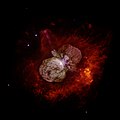Lêer:Eta Carinae.jpg

Grootte van hierdie voorskou: 600 × 599 piksels. Ander resolusies: 240 × 240 piksels | 480 × 480 piksels | 769 × 768 piksels | 1 025 × 1 024 piksels | 2 015 × 2 013 piksels.
Oorspronklike lêer (2 015 × 2 013 piksels, lêergrootte: 163 KG, MIME-tipe: image/jpeg)
Lêergeskiedenis
Klik op die datum/tyd om te sien hoe die lêer destyds gelyk het.
| Datum/Tyd | Duimnael | Dimensies | Gebruiker | Opmerking | |
|---|---|---|---|---|---|
| huidig | 09:41, 18 Desember 2017 |  | 2 015 × 2 013 (163 KG) | The NMI User | Reverted to version as of 14:14, 1 May 2008 (UTC) |
| 14:45, 13 Maart 2017 |  | 3 000 × 2 998 (1,18 MG) | Leogorgon | larger file size | |
| 14:14, 1 Mei 2008 |  | 2 015 × 2 013 (163 KG) | Vol de nuit | {{Information |Description=(NASA News Release) A huge, billowing pair of gas and dust clouds are captured in this stunning NASA Hubble Space Telescope image of the supermassive star Eta Carinae. Using a combination of image processing techniques (ditheri |
Lêergebruik
Daar is geen bladsye wat dié lêer gebruik nie.
Globale lêergebruik
Die volgende ander wiki's gebruik hierdie lêer:
- Gebruik in da.wikipedia.org
- Gebruik in en.wikipedia.org
- Star
- Eta Carinae
- Wikipedia:Selected anniversaries/March 11
- Wikipedia:Today's featured article/March 2017
- Wikipedia:WikiProject Wikipack Africa Content/Wikipedia:Showcase
- Wikipedia:WikiProject WikiFundi Content/Eta Carinae
- Wikipedia:Today's featured article/requests/Eta Carinae
- Wikipedia:Today's featured article/March 12, 2017
- Wikipedia:Main Page history/2017 March 12
- Wikipedia:WikiProject WikiFundi Content/Wikipedia:Showcase
- Wikipedia:Main Page history/2022 March 11
- Wikipedia:Main Page history/2022 March 11b
- Wikipedia:Main Page history/2023 March 11
- Wikipedia:Main Page history/2023 March 11b
- User:2003 LN6/sandbox/Eta Carinae variable
- List of luminous blue variable stars
- Gebruik in en.wikiversity.org
- User:Marshallsumter/Radiation astronomy2/Visuals
- User:Marshallsumter/Radiation astronomy2/Violets
- Stars/Astronomy
- User:Marshallsumter/Radiation astronomy2/Violets/Quiz
- Stars/Sun/Astronomy/Quiz
- User:Marshallsumter/Radiation astronomy/Courses/Principles/Hourly 2
- User:Marshallsumter/Radiation astronomy/Courses/Principles/Final quiz
- Draft:Original research/Io/Quiz
- Titan/Quiz
- Stars/Solar systems/Quiz
- Moon/Quiz
- Earth/Quiz
- User:Marshallsumter/Radiation astronomy/Colors/Quiz
- Volcanoes/Io/Quiz
- Stars/Violets
- User:Marshallsumter/Radiation astronomy2/Stars
- Stars/Violets/Quiz
- Gebruik in es.wikipedia.org
- Gebruik in fr.wikipedia.org
- Gebruik in hi.wikipedia.org
- Gebruik in it.wikibooks.org
- Gebruik in la.wikipedia.org
- Gebruik in mk.wikipedia.org
- Gebruik in ms.wikipedia.org
- Gebruik in my.wikipedia.org
- Gebruik in oc.wikipedia.org
- Gebruik in ru.wikipedia.org
- Gebruik in sk.wikipedia.org
- Gebruik in sr.wikipedia.org
- Gebruik in th.wikipedia.org
Wys meer globale gebruik van die lêer.
